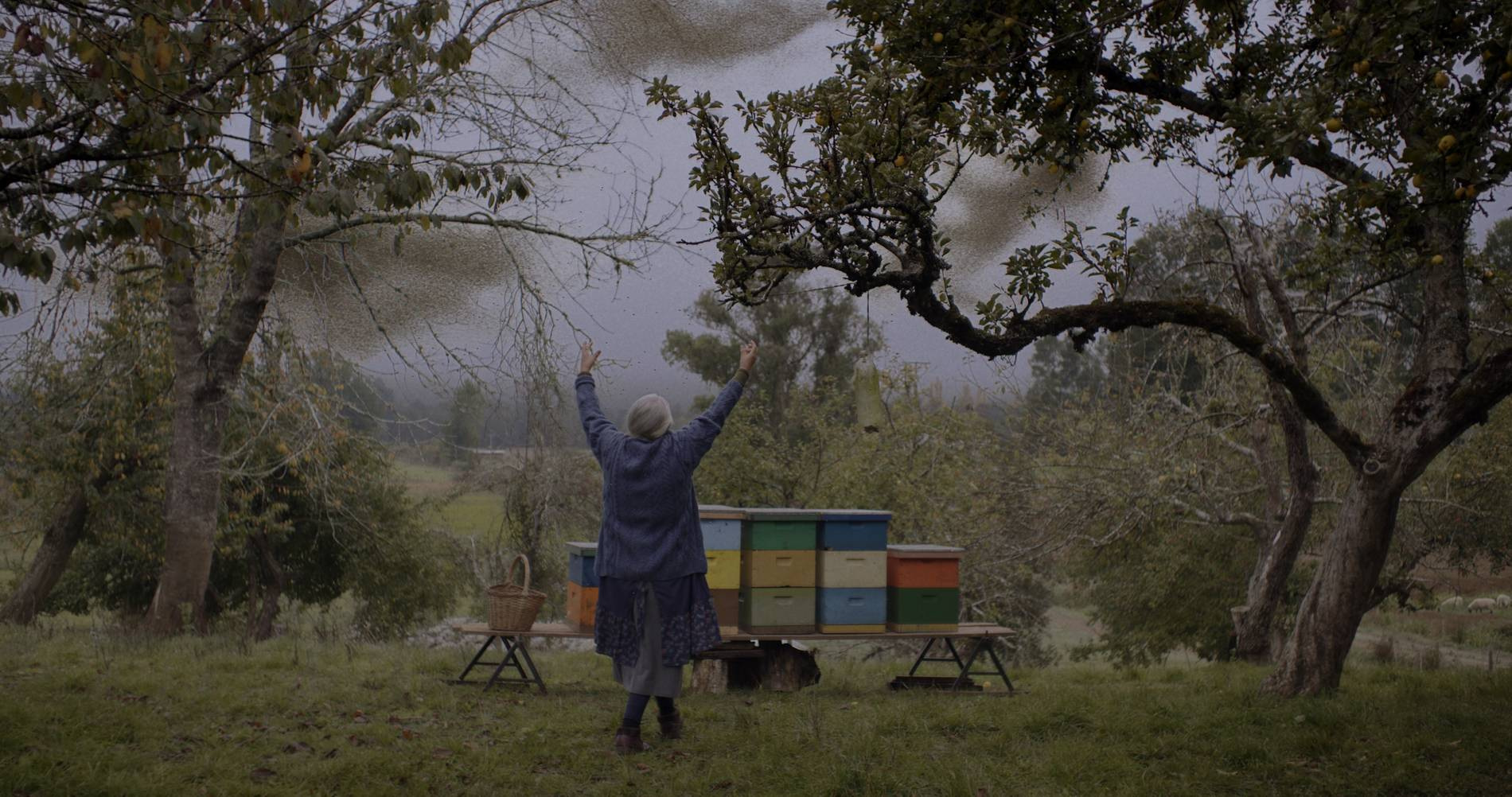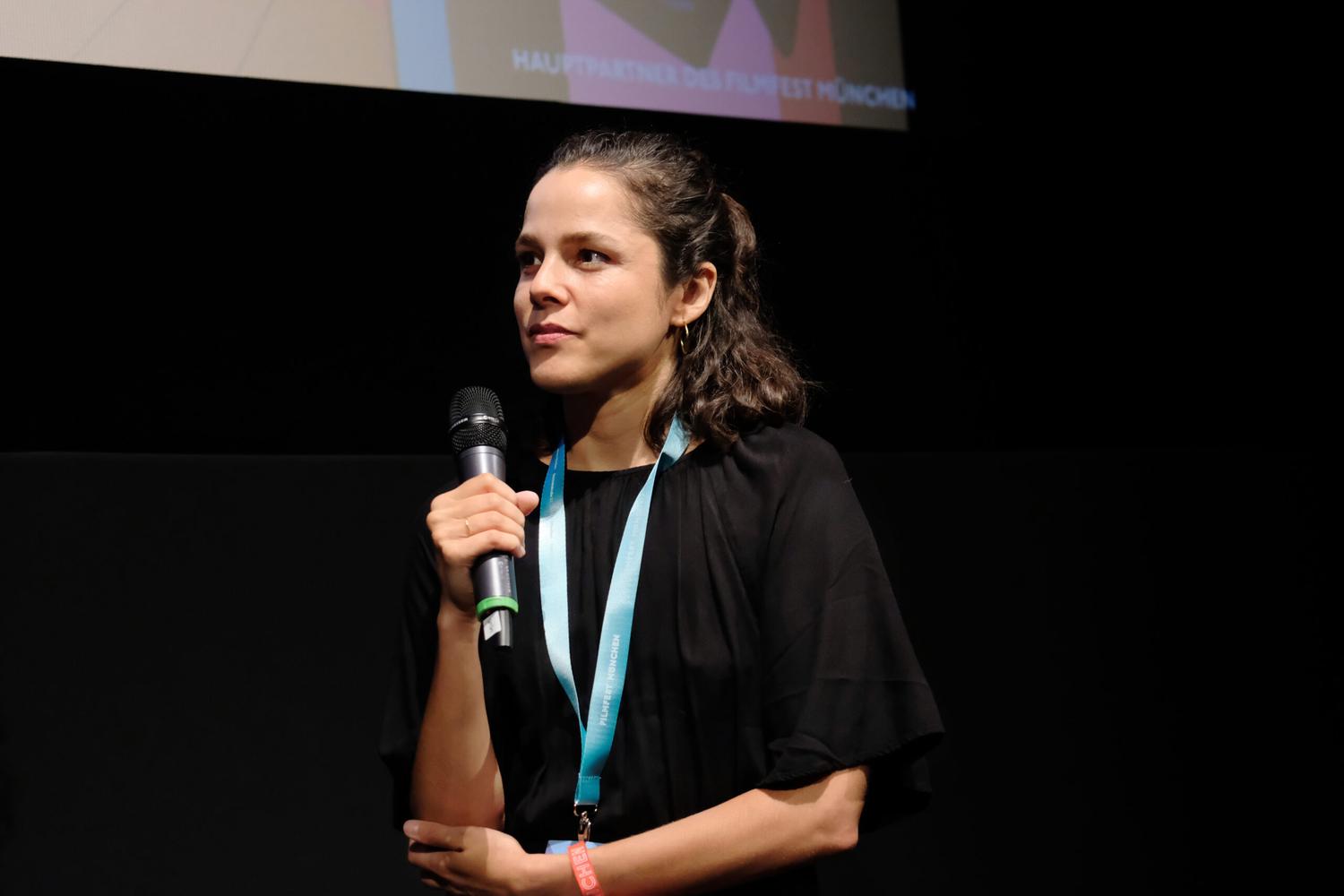
Vol. 15 // The Cow Who Sang A Song Into The Future
In Conversation with Francisca Alegría
Francisca Alegría’s genre-defying film confidently embeds environmentalism commentary into familial drama, asking subtle questions of ownership and treatment between humans and nature. In our interview with Alegría, the writer-director shares her personal ties to the film, the environmentalist context that informed the project, and her perspective on the film’s magical realism.

Indie: Your debut features similar themes to your short film And the Whole Sky Fit in the Dead Cow’s Eye. What was the evolution from the short to this feature?
Francisca Alegría: I wrote the first draft of the feature before writing the short. All the main characters of the family are based on my family, so I started writing in a territory that was known to me. I left that script aside but then I had to graduate with something. I did not want to do a capsule of what I had in my mind but the short is within the same universe though we shot the film in a different landscape. They have these similarities, I feel like they live in the same world.
Throughout The Cow Who Sang A Song Into The Future, the repeated image of this singular cow is so memorable. What is it about that creature that is a fascination in your work?
I grew up going to my grandparents’ farm and our attention was always on the horses. Horses were talked about as these majestic creatures. The cows were in the background, characterized as dumb and disposable and people took their milk and made products out of them. Although at the beginning this didn’t come rationally, I wanted to talk about [cows] because they represent something very feminine. They give a lot, cows are very abundant. In some countries and religions cows are sacred but on our side of the world, they are exploited and looked down on. I was raised saying the cows were dumb, but I came to understand they’re amazing animals. They give so much but we give them pain.
Environmentalism has a lingering, ominous presence throughout the film that is both locally specific and universally recognizable. Tell me about forging that context.
Going away from my country gave me that perspective; I started seeing many things that were happening that people weren’t talking about. In 2017, in the Cruces River, where we shot the film, more than 2,000 fish died. People knew it was because of a pulp factory. That factory has a lot of power and money, so they managed to put that under a rock and no one took responsibility. I started digging into that, and not even with the mass death of animals we are shocked. It shocked me. This is the world we’re living in, so let’s concentrate on this here because I wanted to not be oblivious.
In reflecting on the relationship between humans and nature, the film’s dialogue blends into the soundtrack where animals and landscapes seem to sing. Why did you decide on this communicative method?
I tried to not only have the human characters express themselves but also the fungi world, the plants, trees, and animals. I thought, “How can we bring a musicality I’ve perceived when I’m in the woods to the film?” From the beginning, we started creating the chorus and thinking about sound. Later in the process, when we were ready to shoot, I met with French composer Pierre Desprats. I don’t speak French, and he doesn’t speak Spanish, so our collaboration was very experimental. We wanted to stay open to how it felt along the journey, we just allowed ourselves to imagine and play a little with that. It’s my dream to make a full musical one day.
How did you land on the approach of magical realism that defies genre in the film’s visuals and narrative?
After a big traumatic event in my youth, something opened and I had a really private inner world. I imagined things that were never realistic, [with hindsight] I see it was a defense mechanism. It’s the way in which I like to see things, I never even thought that I wanted to place [the film] in a genre. It’s really fun to hear that conversation, some people place it in magical realism, others grounded sci-fi, and others see fantasy. I think it has elements of the three but doesn’t marry with one.
Speaking about magic, Magdalena’s grandchild, Tomás, is such a unique presence in the film. They’re placed in a space where gender identity, queerness, and magic intersect. How was crafting that character?
Tomás is the character in whom I place myself. When I came out as bisexual, my mother could not handle it and I went through a period of time where I was hurting a lot. I think I was taking that out through Tomás. I decided on a transitioning person because nowadays being bisexual is normal but what I went through would be equivalent, almost.
Meeting Enzo [Ferrada Rosati], was great because he did not go through that experience. He knew he was gay and his family were all very accepting. I feel like queerness nowadays and saying it out loud is such a relief. This new generation is teaching us so much, they move forward without fear. Magdalena was a woman from a different period where she could not express herself either. Because of her circumstances, without internet and community, the only way out was suicide. But, now, Tomás has other possibilities.
‘The Cow Who Sang A Song Into The Future’ Film Review

Chilean filmmaker Francisca Alegría’s feature debut The Cow Who Sang a Song Into the Future begins with a brief tour of the local ecosystem. The camera glides over a dead rat, poisonous mushrooms, and ants navigating a tree trunk before rising up to reveal the River Cruces. The long stretch of water glistens in the sun but under the surface, something supernatural is brewing.
Simultaneously a ghost story, a portrait of familial grief, and a meditation on environmentalism, The Cow Who Sang a Song Into the Future is essentially the full-length contemplation of Alegría’s 2017 Sundance award-winning short film And The Whole Sky Fit In The Dead Cow’s Eye. The feature propels into action when Magdalena (Mia Maestro) rises from the dead. Bursting out of the river where she committed suicide, she clambers onto the muddy bank and gasps for air surrounded by fish doing the very same. The film then tracks Magdalena’s wanderings into her past life – with mud streaked on her cheeks and her leather jacket still saturated – as she reunites with those she left behind.
With its haunting depiction of loss, Alegría’s genre-blending film effortlessly melds magic realism and grounded drama. The camera closely observes as Magdalena’s connection with civilization is steeped with sci-fi elements; in her presence, technology buzzes into life. While electronics whir, her widowed husband (Alfredo Castro) is struck with debilitating shock. Declaring his wife has risen from the dead, their daughter, Cecilia (Leonor Varela), now with her own children, is quick to return to the family’s dairy farm to care for him.
Magdalena’s presence, akin to a cold chill in the room, divides the household. She wanders through a once familiar world and is met with shock from the housekeeper, Felicia (María Velásquez), but fierce anger from her daughter. When they come face to face in the beautifully eerie woods, Alegría frames their meeting like a Western standoff in a wide shot that only emphasizes the distance forged between them. With grief bubbling to the surface, a complex, multifaceted reality of loss rekindled comes to the foreground.
It is rather astonishing how much Maestro’s performance is able to communicate with complete silence. Expressing multitudes in quietude, she imbues the otherwordly character with warmth, despite the chill that arrives with her return. Similarly, Varela’s execution as a studious but stressed surgeon ties the family together. It is in her resistance to receiving her mother again that Alegría finds a focus. Varela gently crumbles Cecilia’s hard shell, she softens to the world around her and becomes open to tangling herself in the roots of the world she had left behind.
Magdalena’s supernatural presence uproots not only Cecilia’s life, but her surroundings too. Local wildlife begins dying en masse; fish wash up dead, bees return drowsy, and the cows become plagued by unexplained ailments. The cyclical nature of life and death orbits the film with its ponderings on mother nature, and cinematographer Inti Briones does a fantastic job of framing such devastation with atmospheric emotion. The merging of the human and the natural is subtly captured; climate protesters ride their bikes in the triangle formation of birds and the river’s powerful current seems to run through Magdalena’s body with fantastical power.
The most tender moment in the film, somewhat surprisingly, is between Cecilia and an isolated cow. One night she ventures into the nearby woods to clear her head and comes across a cow with a 2222 tag on its ear. In what could be a silly moment, Alegría lingers and lets imagination spiral. The lone cow – appearing like an omen, angel, or fabled creature – is especially mysterious when the next morning it is back in its pen to be inseminated. Unexpectedly emotional, the quiet scene is only bolstered into soft devastation when it’s revealed Magdalena was vehemently opposed to their cows being separated from their calves in order to collect their milk for profit. Here, Alegría draws parallels between Cecilia’s relationship with motherhood and that of postpartum livestock. Such pointed commentary on the exploitation of animals for human benefit underscores much of the film but in this feminine comparison, it becomes unavoidable.
The Cow Who Sang a Song Into the Future also harbors an environmentalist perspective in its soundscape. The film fuses an evocative soundtrack with subtle lyricism and natural calls of mother nature; flora and fauna seem to harmonize like a choir. The cow’s moos add another layer and, after a while, begin to sound like cries. “We see death ahead” is hauntingly sung, giving voice to the landscape that has been subjected to the greedy hands of profit-hungry men. While navigating mythic possibility, such pointed thought roots Alegría’s more hypnotic sequents in a very real, taut tension.
The film is embedded in this moment of transition. The sun is always low, setting or rising, in a time of discovery, realization, and attempted healing. The former directly relates to one of the film’s central family members, Tomás (brilliant Enzo Ferrada). Magdalena’s gender-nonconforming grandchild is exploring their identity but parallels are drawn between them and Magdalena. Alegría cuts from Magdalena’s bare feet traversing the road to Tomás’ own treading down a pier, the visual connection also develops into something more emotional. Magdalena seems to find belonging in the presence of Tomás, both shown to be outsiders in this world. With them, Magdalena manages to “speak” and, subsequently, be heard.
The Cow Who Sang A Song Into The Future is a wonderfully nuanced portrait of intergenerational connection and the cost of just taking from the landscape that gives so much. With powerfully meditative and thoughtful handling, Alegría’s folkloric film may start with death but concludes on a more optimistic note. Hope lingers that it’s not too late for Magdalena’s family to wake up to the world around them, and maybe it’s possible for us to do the same.